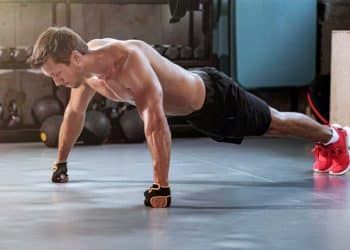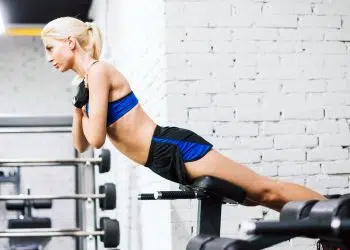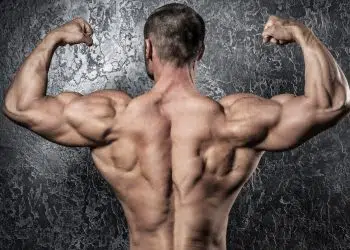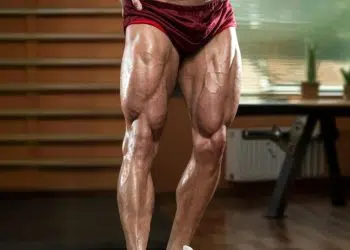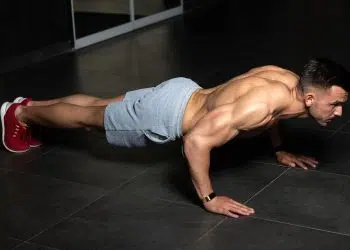Plank-based exercises such as oblique-focused side bridges help to build a solid strength foundation in the core and entire body. Isometric in nature, bracing your midsection and keeping the hips strong will have carryover to functional activities and everyday tasks. Whether you’re young or old, bodyweight and weighted bridge variations can offer many physiological benefits, and we all know they’re a good test of mental strength. There’s something about isometric holds that toughens up the mind.
In this guide, we’ll go over proper movement tips, benefits, best variations, optimal sets/reps, and programming side bridges.
How To Do Side Bridges
Side bridges are an intermediate exercise because you do need to have decent total body strength, healthy shoulder muscles, balancing ability, and a basic understanding of exercise mechanics.
Step 1: Setup
Assuming the correct exercise position is half of the movement.
To do it:
- Lie in a side plank position by planting your forearm on the ground and stacking one leg on top of the other to support your body weight. Your top leg should lie on top of the bottom leg so that your feet are together and pointing in the direction you’re facing. You can place the top hand on your hips for balance.
Pro tip: Keep your upper arm vertical under your armpit and close to your body for optimal support and shoulder stability.
Level Up Your Fitness: Join our 💪 strong community in Fitness Volt Newsletter. Get daily inspiration, expert-backed workouts, nutrition tips, the latest in strength sports, and the support you need to reach your goals. Subscribe for free!
Step 2: Hip raise and crunch
Before you start the exercise, you want to engage and fire up the muscles groups in charge of facilitating the movement.
To do it:
- Lift your hips toward the ceiling as high as you can and crunch down by flexing the side of your torso closest to the floor.
Pro tip: Side bridges work the muscles of your obliques closest to the ground, not the uppermost side of your torso.
Step 3: Drop the hips and repeat
You’ve completed ninety percent of the exercise.
- Now all you have to do is dip your hips down to within an inch from the floor, then repeat for the desired number of repetitions.
Watch the video example below to see how it’s done.
Benefits
The benefits of this exercise outweigh any cons.
Challenging bodyweight core exercise – Side bridges may appear to be an easy exercise but unless you’ve tried them, you may not understand how difficulty they can be, especially when you do them slow and focus on engaging the involved muscle groups.
Total body exercise – While some muscles are more involved than others, side bridges activate the entire body. The advantage is increased total core activation, improved muscular balance, isometric strength development from head to toe, and engagement of stabilizer muscles.
Weight dependent – This may also be considered a con but because side bridges are a bodyweight exercise, heavier people will have more resistance to work with which will make the exercise more challenging.
Drawbacks
Are there potential drawbacks to doing side bridges?
Bodyweight based – Like we mentioned, your body weight being the resistance can be a drawback because if you’re too light but are strong, then side bridges won’t be as challenging for you. But, you could simply strap on a weighted vest and solve that problem!
Requires upper body and core strength – To do side bridges, you have to be able to do a side plank. That means you need to have not just a strong core and hips but enough arm strength to keep yourself up during the movement.
Not good for those with bad shoulders – If you have painful shoulders, then here are 13 ways to avoid deltoids pain in the gym. Because you’ll need to support your weight using one arm a time, healthy deltoids are a must.
Level Up Your Fitness: Join our 💪 strong community in Fitness Volt Newsletter. Get daily inspiration, expert-backed workouts, nutrition tips, the latest in strength sports, and the support you need to reach your goals. Subscribe for free!
Common Mistakes
Here are some tips to help you avoid mistakes that will make side bridges less effective.
Pushing with your arms – It’s called side bridges, not side push-ups. The movement should occur at the hips to work your oblique and core muscles but if you don’t know how to perform the movement, the arms may do what they’re not supposed to.
Going too fast – Side bridges are better when you do them a little slower and with control, focusing on working the target muscles. But you’ll see people doing ab work so fast that it becomes a cardio activity. Squeeze the obliques and try to visualize them contracting and elongating, also known as mind-muscle connection. This is also important to ensure both side are being trained equally with the same range of motion and intensity.
Too little movement – Another common gym offense is using micro movements and thinking you’re doing something. Well, you may develop some strength but you need to train each muscle using enough range of motion to stimulate growth through what we know to be the concentric (muscle contraction) and eccentric (muscle lengthening) phases of a repetition.
Variations
Side bridges are the bomb when you need a bodyweight only oblique exercise. But we also like and recommend these variations that work all the same muscles but offer their own unique advantages.
1. Single leg side bridge
An easy way to make side bridges instantly more challenging is to lift the top leg and hold it up throughout the duration of a set. And that, ladies and gentlemen is how you really challenge the target muscle groups. Your obliques will be screaming after this minor technique modification.
2. Basic plank/side plank
You can’t go wrong with a basic plank but it’s more of a beginner exercise or test of muscular endurance and mental grit. If you can hold a plank for one minute straight then it’s probably time to try something new and harder.
Related: The Best Plank Progressions and Variations for Stronger Abs
3. Side plank crunch
Activate more of the abdominal or six pack muscles with this side bridge crunch variation.
To do it:
- Get in a side plank position.
- Lift the top leg toward the ceiling.
- Simultaneously crunch the knee of your top leg and your upper body toward each other and contract the core muscles.
- Return to the starting position and repeat for the desired number of repetitions.
4. High side plank
Elevate side bridges by supporting your weight on a fully extended arm rather than your forearms.
5. Rolling side plank
Alternate switching from your left to right side with a rolling bridge variation. You’re essentially just turning over and from there you can do a side bridge or remain in a plank.
6. Side bridge with oblique twist
If you’re truly ready to step up your ab game, incorporate an oblique twist into the side bridge. To do it you’ll assume the side plank position, place your hand on the back of your ear, and twist your torso down toward the floor.
Pro tip: Make this variation more challenging by twisting your torso toward the floor and reaching the top arm under your body and straight through.
Programming Side Bridges In Your Workouts
Side bridges are best done in a core-only workout, as a warmup exercise before more advanced movements or after a workout as a finisher with other plank variations.
Related: How Many Calories Do You Burn Doing Side Planks?
Sets/Reps
What are the optimal number of sets and reps for side bridges? Well, it depends on a few factors such as your body weight, training level/strength, and goals. Unlike other exercises where the resistance can be adjusted, your weight doesn’t change. Therefore, you’ll need to get on the floor and do a few reps to see where you’re at. Then you can better determine the best sets and reps numbers for you.
- Generally, we recommend 2-4 sets of 8-25 reps.
Muscles Worked

- Obliques – Located on either side of the rectus abdominis, we have two pairs of obliques – external and internal. External run from the ribs to the pelvis while internal are under the rectus abdominis and sit on the hip pockets. These muscles allow us to twist to either side. Obliques are the target muscle group in side bridges.
- Rectus abdominis – also known as the abs for short, the rectus abdominis muscles are the primarily visible core muscles in the midsection. The abs are what we use to do exercises like crunch variations. The deeper abdominals muscles help us to brace during heavy lifting and keep our torso rigid during side bridges.
- Adductor Brevis – Adductor brevis is one of the several adductor muscles that pulls the thigh inward toward the center of the body. It’s also a trunk stabilizer while also helping to maintain balance and flexion of the thigh muscles.
- Adductor Longus – Longus is another adductor muscle that pulls the thigh inward with the help of others in its family. It along with adductor brevis and magnus is one of the strongest muscles of the thigh.
- Deltoid Lateral – Giving that highly sought after roundness and width to the upper body, the deltoid lateral aesthetically tie everything in and are important muscles. They allow us to lift the arm up laterally whilst also having other functions in the upper body like preventing glenohumeral (shoulder) displacement when the arm is pressed up against the body under resistance.
- Glutes – The glutes have three distinct muscles – maximus (also the largest muscle in the human body), medius and minimus (smallest). They each do something different but they function to extend, adduct, abduct, and externally and internally rotate the thigh.
- Iliopsoas – The primary hip flexor, iliopsoas is made up of major and minor psoas muscles and the iliacus. Iliopsoas lets us bring the upper leg past a 90-degree angle and its muscles can function together or individual of each other.
- Pectineous – The pectineous muscle assists the adductors, and acts as a medial rotator and hip flexor.
Bottom line
As long as you have your side bridges, you don’t need to worry about whether your one oblique exercise will give you the results you need. You should have a variety of movements in your arsenal to build core strength, and when it comes to bodyweight movements, side bridges are one of the best plank exercises because they’re challenging for all experience levels.
Interested in measuring your progress? Check out our strength standards for Push Ups.


